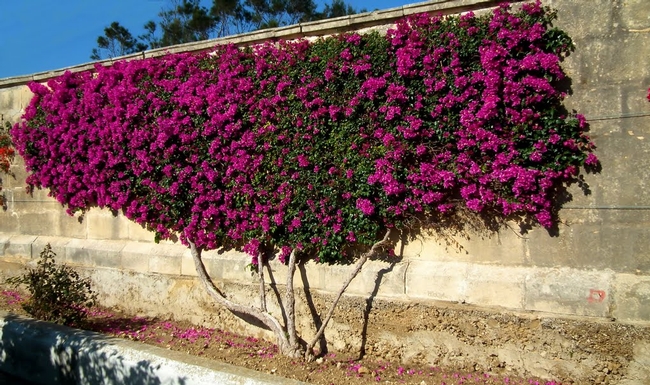
Bougainvillea ( Bougainvillea spp.) are tropical vines from Brazil that are happiest close to the Equator, so success with these beauties will depend on your ability to make them feel at home. At least five hours of direct sunlight a day is necessary for the colorful blossoms and bracts that make bougainvilleas vibrant standouts, and warm temperatures and excellent drainage are a must. Heat lovers, they can handle temperatures over 100 degrees, but do not like temperatures below 60 degrees. (USDA Plant Hardiness Zone 9-11) Vines that are damaged by cold or frost in our area can usually be cut back and will regrow when the weather warms.
Grown primarily for their brilliantly colored carpals, a close look reveals the actual flowers of bougainvilleas are small, insignificant and usually white or cream colored. But each flower is surrounded by several sets of papery carpals in colors so brilliant, they can be seen for miles.
Colors range from deep purple, magenta, cerise, pinks, reds, yellows and whites.
They can be grown in the ground, or in pots or baskets: enjoy them in the summer months, and bring them in when it gets too cold.
Bougainvillea are drought tolerant once they are established. They do not like wet feet, so if you plant them outside, higher ground is best. Drainage is important whether you plant them in the ground or in a pot. If you plant in a pot, do not use a saucer or water dish. Too much water or waterlogged roots can cause bracts to drop, or your plant to stop blooming completely.
Bougainvillea in pots and baskets do very well, provided they get enough light. They also do better with constrained and crowded roots, so do not be in a hurry to repot.
Bougainvilleas grow best in quick draining, loamy soil that is equal parts clay, sand and silt, and amended with compost or organic matter to allow oxygen and nutrients to easily reach the fragile roots. Do not use any water retention types of mixes or ingredients. The excess water can cause root rot and leaf spots to appear.
Water only when the surface soil has dried, or the plant is slightly wilting. Then water deeply.
Avoid frequent, light watering; it promotes a weak root system and weakens the color of your plant.
The blooming cycle for bougainvillea is typically four to six weeks. Since bougainvillea blossoms only on new growth, pruning and pinching are important techniques to promote abundant growth and flowering.
Pruning can be done at any time of the year, and is used to shape the plant. Bougainvillea can be pruned hard to restrict growth, and stems can be pruned to create branching. Shaping your plant depends on if you want it to grow aggressively for a hedge, vertically to cover a trellis, or want it to be full, bushy and overflowing for a pot or hanging basket.
Pinching is important. Pinching is the method of removing the soft, growing tips of young plant stems to encourage fuller growth. The more you pinch, the more your bougainvillea will branch and bloom, so prune and pinch after a flowering cycle has completed.
For great color and abundant blossoms, feed your plant. Bougainvilleas are heavy feeders, but have delicate root systems. Specialized fertilizers for bougainvillea are available, and one of their distinguising factors is the inclusion of iron and other micronutrients. Read your fertilizer label and follow the directions. Applications will be more frequent during the flowering months, and should be cut to half during the non flowering months, especially when temperatures are cool.
Bougainvillea should come with warning signs. Long, sharp thorns can tear clothes and puncture skin, and often cause dermatitis or small infections for many gardeners and passerbys who are allergic to the thorns. One source I read suggested planting them 3 feet away from paths or patios, and to avoid planting them near swimming pools, play area or other areas of the garden people may be more likely to be scraped or scratched.
While the leaves of bougainvillea are not toxic, the sap of the plant is mildly toxic and a prick from the thorns can result in itching, swelling, burning, blisters or sores. Of course, this can also be used to your advantage. Bougainvilleas are aggressive growers and can be easily shaped into massive hedges. Many homes with yearlong warm temperatures plant bougainvillea as an effective and colorful security fence.
UC Master Gardeners of Napa County is recruiting for the Class of 2015! Applications are available at two information meetings:
Friday July 11, 12.30-2.00
Tuesday July 22, 6-7.30
At 1710 Soscol Ave., Suite 4, Napa, CA 94559.
Master Gardeners are volunteers who help the University of California reach the gardening public with home gardening information. Napa County Master Gardeners ( HYPERLINK "http://ucanr.org/ucmgnapa/" http://ucanr.org/ucmgnapa/) are available to answer gardening questions in person or by phone, Monday, Wednesday and Friday, 9 a.m. to Noon, at the U. C. Cooperative Extension office, 1710 Soscol Avenue, Suite 4, Napa, 707-253-4143, or from outside City of Napa toll-free at 877-279-3065. Or e-mail your garden questions by following the guidelines on our web site. Click on Napa, then on Have Garden Questions? Find us on Facebook under UC Master Gardeners of Napa County.
Napa County Master Gardeners welcome the public to visit their demonstration garden at Connolly Ranch on Thursdays, from 10:00 a.m. until noon, except the last Thursday of the month. Connolly Ranch is at 3141 Browns Valley Road at Thompson Avenue in Napa. Enter on Thompson Avenue.
Attached Images:
